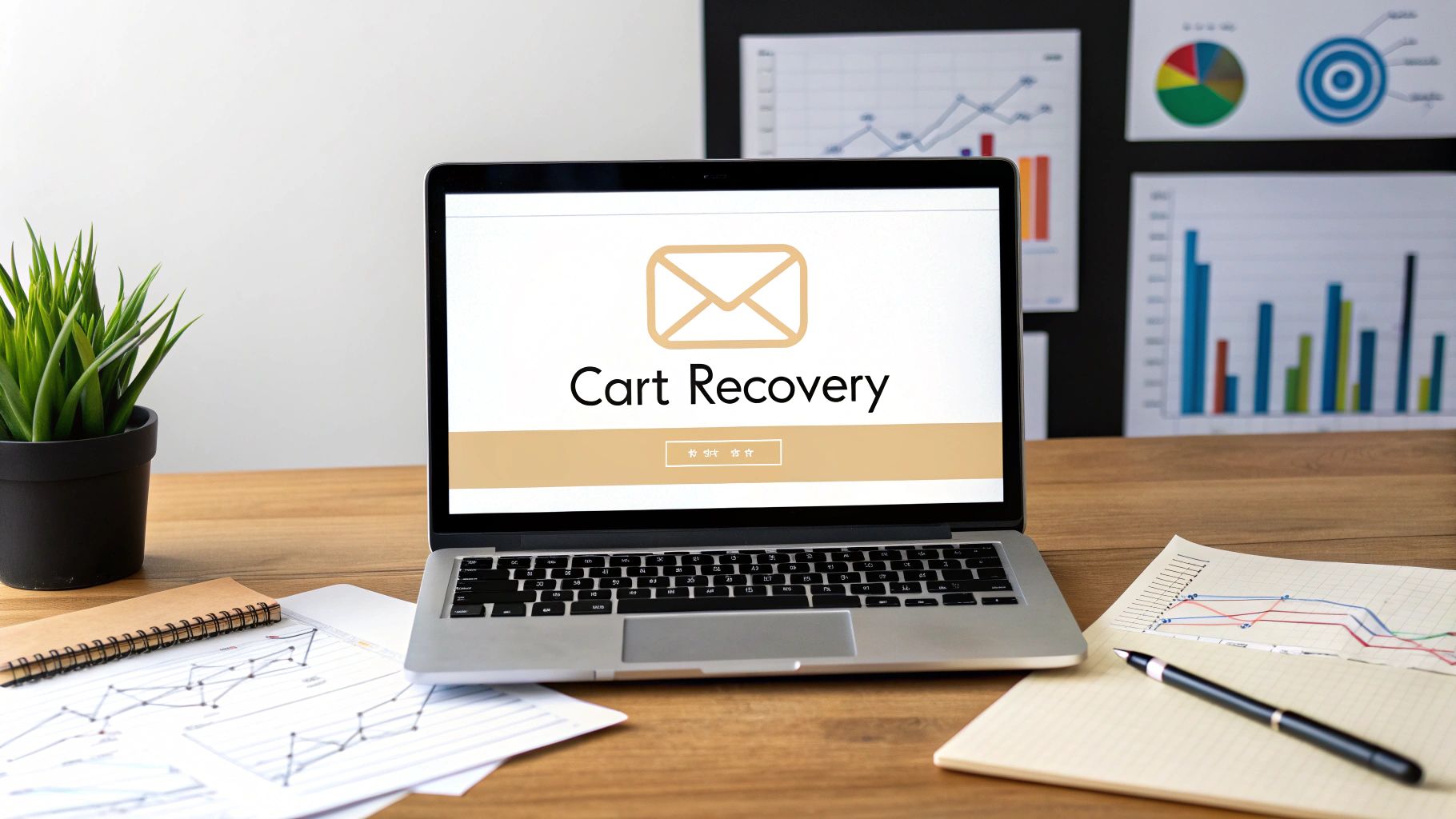Let's be honest. That default abandoned cart email you set up feels like a leaky bucket. You know it's catching some sales, but you have that nagging feeling you're leaving a fortune on the table. How much? According to the Baymard Institute, the average cart abandonment rate is a staggering 69.99%. For every 10 shoppers who add an item to their cart, 7 simply walk away.
From our experience with over 500 Shopify stores, this is the silent profit killer. But what if you could turn that leaky bucket into a high-pressure fire hose of recovered revenue? The key isn't just sending an email; it's about sending the right message at the right time.
In this playbook, we'll break down the best abandoned cart email templates from top platforms like Klaviyo, Shopify, and even show you how to supercharge them with WhatsApp. You'll learn not just what to send, but why it works, and how to replicate these high-converting strategies for your own store. For broader insights, explore these powerful email sequence templates to master your follow-up game.
1. The Game Changer: Go Beyond Email with Kanal's WhatsApp Abandoned Cart Flows
While traditional abandoned cart email templates are crucial, they're capped by industry-average open rates of 20-30%. A common mistake we see is brands relying solely on a crowded inbox. To truly maximize revenue recovery, you need to meet customers where they are. This is where we, as an official Meta Business Partner, see a massive opportunity: moving the conversation to WhatsApp.
Kanal's WhatsApp Abandoned Cart feature is designed to supplement your email strategy, leveraging a channel with a staggering 98% average open rate. Instead of just a static email, you can deploy automated, conversational flows that reconnect with shoppers instantly. It’s not just a reminder; it's a personal, two-way dialogue that resolves questions and drives conversions right in the chat.
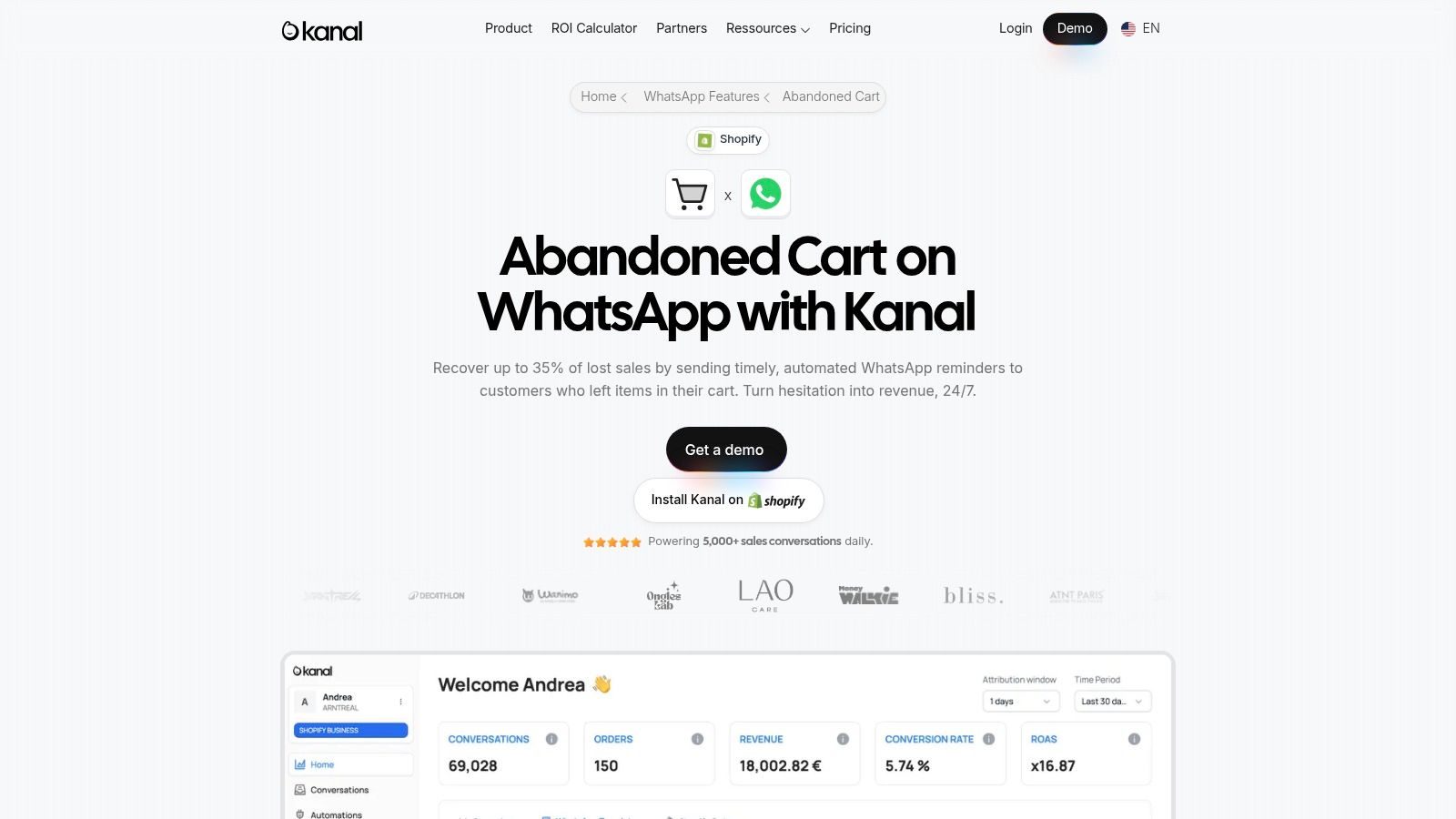
Why Kanal Stands Out from Other Abandoned Cart Apps
What sets Kanal apart is its seamless, no-code automation built for Shopify merchants. We pull cart data in real-time to trigger personalized messages. Our intuitive drag-and-drop flow builder allows you to craft sophisticated sequences without writing a single line of code. You can A/B test messages, add dynamic upsells, and include unique discount codes to incentivize checkout.
We’ve seen clients achieve up to a 12x ROI by implementing these flows. The strategy that consistently delivers the best results for our clients is a multi-touchpoint approach: combining a quick WhatsApp reminder with a follow-up email. This ensures you reach customers on their preferred channel.
Key Features & Strategic Advantages
- No-Code Conversational Flow Builder: Easily design custom WhatsApp sequences. You can set time delays, segment users based on cart value (their potential Average Order Value or AOV), and personalize messages with customer names and product images.
- AI-Powered Personalization: Go beyond "Hi [Name]". Kanal’s AI helps craft messages that feel human and relevant, turning a simple reminder into a helpful customer service interaction.
- Deep Shopify Integration: Our connection is seamless, ensuring cart and customer data are always in sync for hyper-targeted campaigns and accurate tracking.
- Holistic Marketing Ecosystem: Kanal integrates with tools like Klaviyo and Yotpo, allowing you to unify your marketing across email, SMS, and WhatsApp. Explore more of the best WhatsApp apps for Shopify to see how a powerful tech stack comes together.
- Transparent Analytics: A built-in dashboard provides a clear view of your campaign performance, including open rates, recovery rates, and Return on Ad Spend (ROAS), so you can optimize for better results.
Visit Kanal's Website to see our abandoned cart feature in action.
2. Klaviyo: The Data-Driven Powerhouse for Email
For e-commerce brands serious about data-driven marketing, Klaviyo is an undisputed powerhouse. Its true strength lies in its deep Shopify integration, which allows you to create highly personalized and automated abandoned cart email templates based on real-time customer behavior.
From our experience with hundreds of Shopify stores, the brands that win at cart recovery leverage dynamic content. Klaviyo excels here. Its pre-built abandoned cart flows automatically pull in the exact products a customer left behind—complete with images, prices, and direct links back to their cart. This level of personalization is crucial for reminding shoppers exactly what they were excited about.
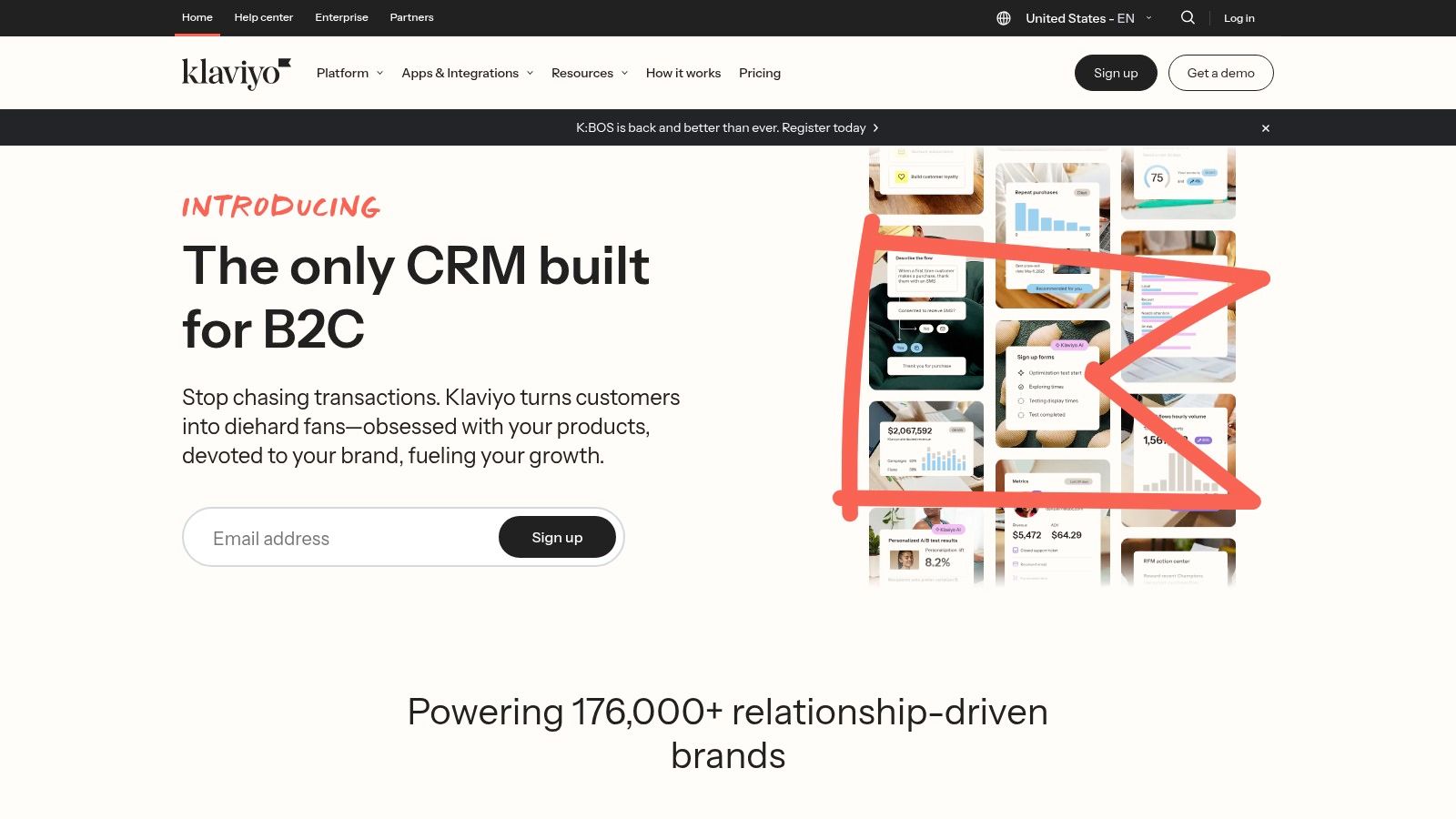
Strategic Breakdown & Key Features
Klaviyo’s platform is built around "flows"—automated sequences triggered by customer actions. Their abandoned cart flow is a flagship feature and one we often see clients use as a benchmark.
- Dynamic Product Blocks: This is non-negotiable. Klaviyo’s drag-and-drop editor makes it simple to insert a block that automatically populates with the items from a shopper's cart.
- Pre-Built Flow Logic: Klaviyo provides a proven, multi-email sequence out-of-the-box, with timing recommendations based on aggregated data from thousands of e-commerce stores. This removes the guesswork.
- Advanced Segmentation: You can create unique abandoned cart experiences for different customer segments. For example, offer a small discount to first-time shoppers but provide a different incentive to increase the Lifetime Value (LTV) of your VIP customers.
- A/B Testing: Easily test different subject lines, email copy, or offers within your flow to continuously optimize your recovery rate.
Pricing and Access
Klaviyo offers a free tier for up to 250 contacts, which is great for new stores. After that, pricing scales based on your contact list size. All features, including the abandoned cart flows, are available on all plans. While powerful, there is a learning curve, but their documentation is extensive. For a deeper dive into crafting compelling copy, find more inspiration with these abandoned cart email examples from Klaviyo.
3. Mailchimp: The Accessible All-in-One Platform
For many businesses starting their email marketing journey, Mailchimp is the go-to platform, celebrated for its user-friendly interface. When it comes to cart recovery, Mailchimp provides straightforward and effective abandoned cart email templates built into its "Customer Journey" feature, allowing for easy setup.
From our work with scaling brands, Mailchimp serves as a fantastic entry point into automated email marketing. Its templates allow you to quickly implement a multi-step recovery sequence. The platform connects directly to your store's data to automatically insert the specific products a customer left behind, a critical first step in personalizing the reminder.
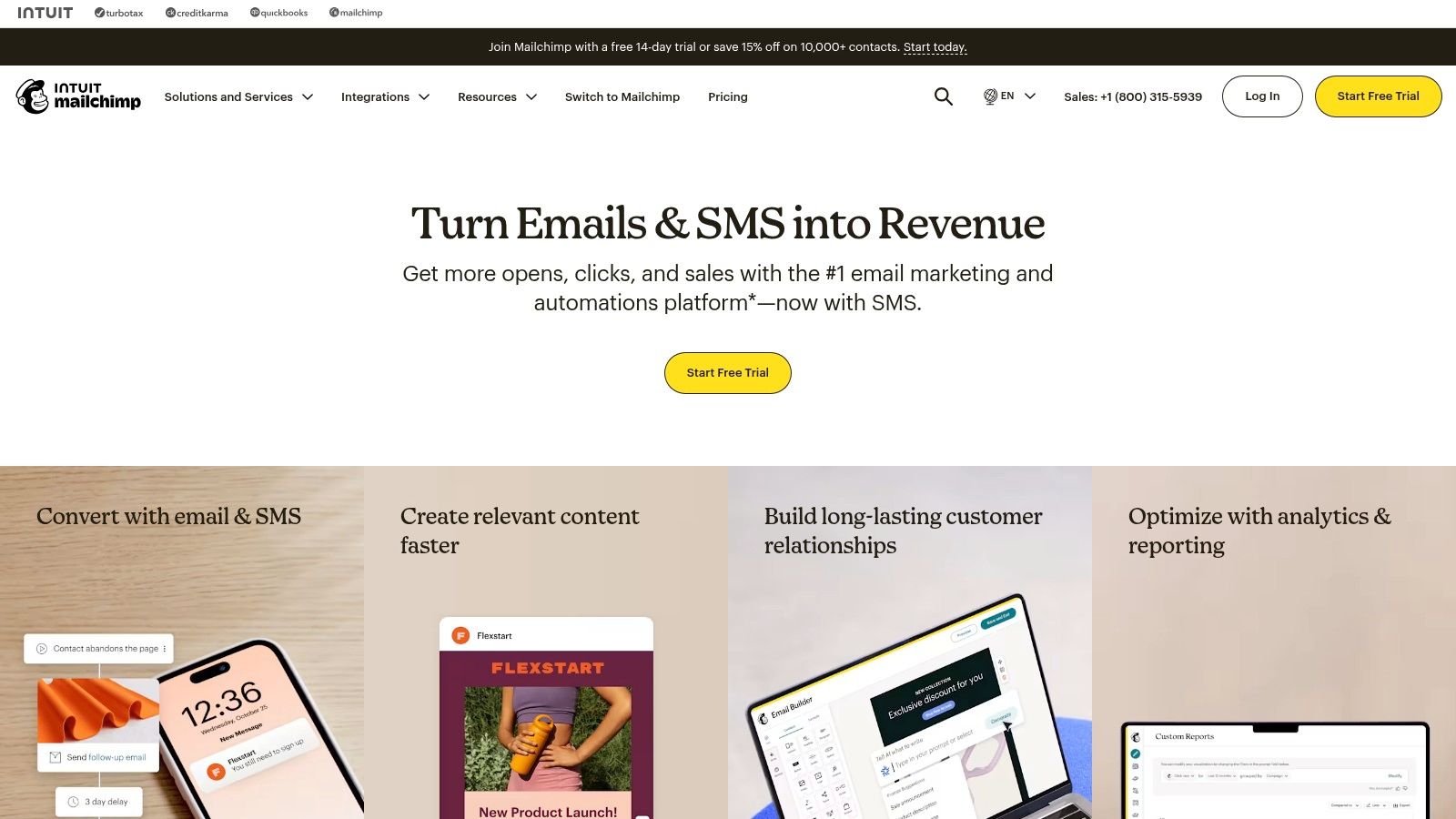
Strategic Breakdown & Key Features
Mailchimp’s strength lies in its simplicity, making automated cart recovery achievable for non-technical teams.
- Dynamic Cart Content Blocks: Mailchimp’s templates include a drag-and-drop block that auto-populates with the abandoned items, images, and links. This is essential for effective recovery.
- Customer Journey Builder: This visual builder lets you create multi-step flows. You can set time delays between emails and even incorporate SMS messages into your abandoned cart sequence for a multi-channel approach.
- Broad E-commerce Integrations: Mailchimp has a massive ecosystem of integrations, ensuring that connecting your store to power these automations is typically a seamless process.
- Extensive Help Resources: The platform is backed by a large support community and a comprehensive knowledge base, making it easy to find tutorials.
Pricing and Access
Mailchimp offers a free plan, but automated abandoned cart emails require a paid plan. While its automation capabilities are not as deeply segmented as some competitors, it provides more than enough power for many growing businesses. For those evaluating different platforms, you can see a breakdown of a powerful alternative in this Mailchimp vs. Klaviyo comparison.
4. Shopify: The Built-In, No-Fuss Solution
For merchants who want a straightforward solution right out of the box, Shopify’s native abandoned checkout feature is the fastest way to get started. While dedicated email service providers (ESPs) offer more advanced logic, you can launch a functional cart recovery email directly from your Shopify admin.
From our experience, the biggest hurdle for new merchants is just getting started. Shopify removes this barrier. Its pre-built abandoned cart email templates can be activated in minutes, automatically pulling in product images, titles, and a direct link to the customer’s checkout. This ensures you don't leak revenue while exploring more complex tools.
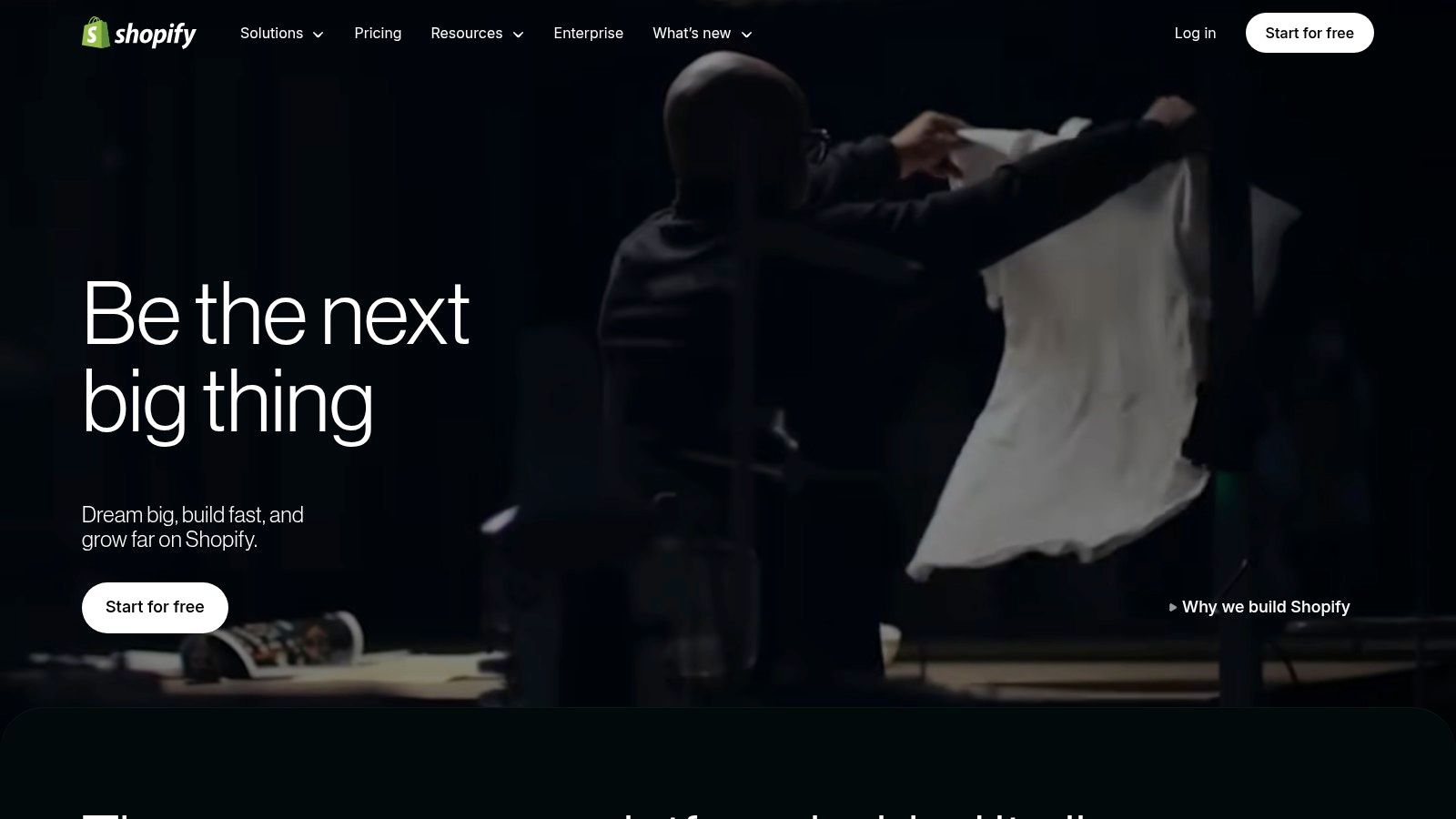
Strategic Breakdown & Key Features
Shopify's approach is to provide a core, high-value feature natively so merchants can see immediate results without extra costs.
- Native & Seamless: Since it's a built-in feature, there are no apps to install or code to configure. It just works. You can get your first abandoned cart email live in under 10 minutes.
- One-Click Activation: You can enable the automation with a single click and set the timing (e.g., send 1 hour, 4 hours, or 10 hours later). It’s incredibly user-friendly.
- Simple Customization: The editor allows you to add your logo, change colors, and edit the subject line and body text. You can also easily add a discount code.
- Centralized Reporting: Track performance directly within your Shopify reports, including how many checkouts were recovered and the total value saved.
Pricing and Access
This feature is included in all Shopify plans, and Shopify Email provides 10,000 free email sends per month. This is more than enough for most businesses to run their abandoned cart automations without extra costs. While Shopify's tool is a fantastic start, it's limited to a single email. For brands looking to build multi-step sequences, we recommend exploring the best abandoned cart apps for Shopify.
5. Beefree: For Ultimate Design Flexibility
For marketing teams that need maximum design flexibility, Beefree is a game-changer. It's not an email service provider (ESP), but a powerful, no-code visual builder for creating stunning, fully responsive abandoned cart email templates. Its key advantage is platform independence; you design the perfect email and then export the clean HTML to use with any sending tool.
A common mistake we see is teams feeling restricted by their ESP's native editor. Beefree solves this by providing a library of professionally designed templates you can customize with a sophisticated drag-and-drop interface. It’s ideal for brands that prioritize a polished, custom-branded look.
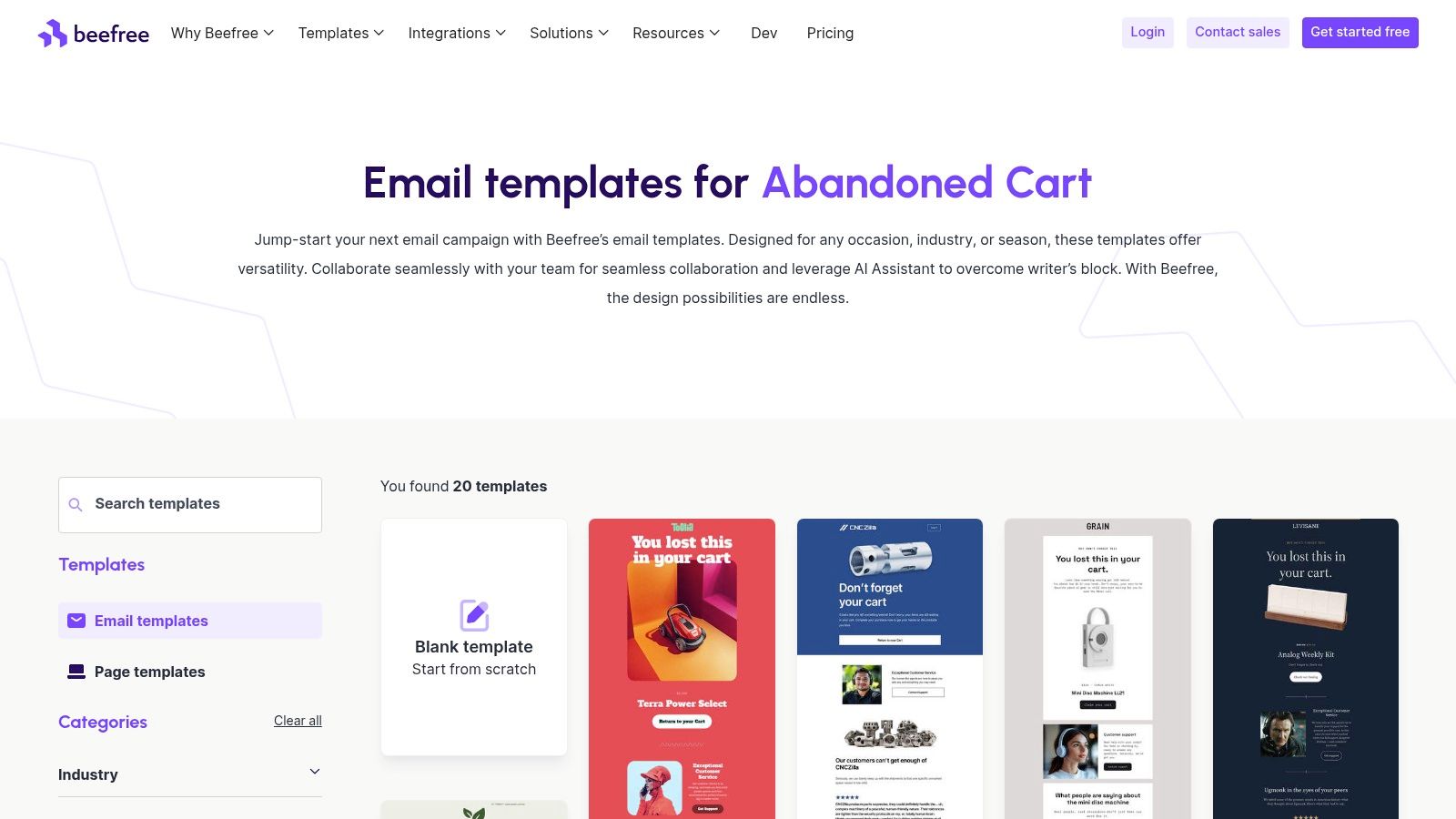
Strategic Breakdown & Key Features
Beefree empowers you to build the visual shell of your email, which you then integrate with your ESP’s dynamic content tags.
- Designer-Made Templates: Beefree offers over 20 pre-built abandoned cart templates. This drastically reduces production time, as the core layout and responsiveness are handled by experts.
- Universal HTML Export: Export a clean HTML file and import it into Mailchimp, Klaviyo, HubSpot, or any other ESP. You then map their specific merge tags to populate dynamic cart content.
- Drag-and-Drop Editor: The builder is incredibly intuitive yet powerful, with features like reusable content blocks and mobile design modes to ensure your emails look perfect on every device.
- Built-in Responsiveness Testing: Designs are verified to render correctly across all major email clients, removing technical headaches.
Pricing and Access
Beefree has a free plan to explore the editor, but a paid plan is necessary to access the full range of templates and export features. Remember, Beefree handles the design, not the automation. You will still need to set up the triggers within your chosen ESP. However, for those who find their current email builder lacking, Beefree provides exceptional creative freedom.
6. Stripo: The Universal Email Design Platform
Similar to Beefree, Stripo is a powerful asset for brands that need design flexibility without being locked into a single ESP. It's a universal email builder with a massive library of pre-built, responsive abandoned cart email templates that you can customize and export to virtually any marketing platform.
What we appreciate about Stripo is its focus on solving the design problem first. You start with a professional template, then use its intuitive drag-and-drop editor for deep customization. It also provides clear guidance on how to insert the dynamic merge tags required by your ESP (like Mailchimp or HubSpot) to pull in abandoned product details. It democratizes great email design.
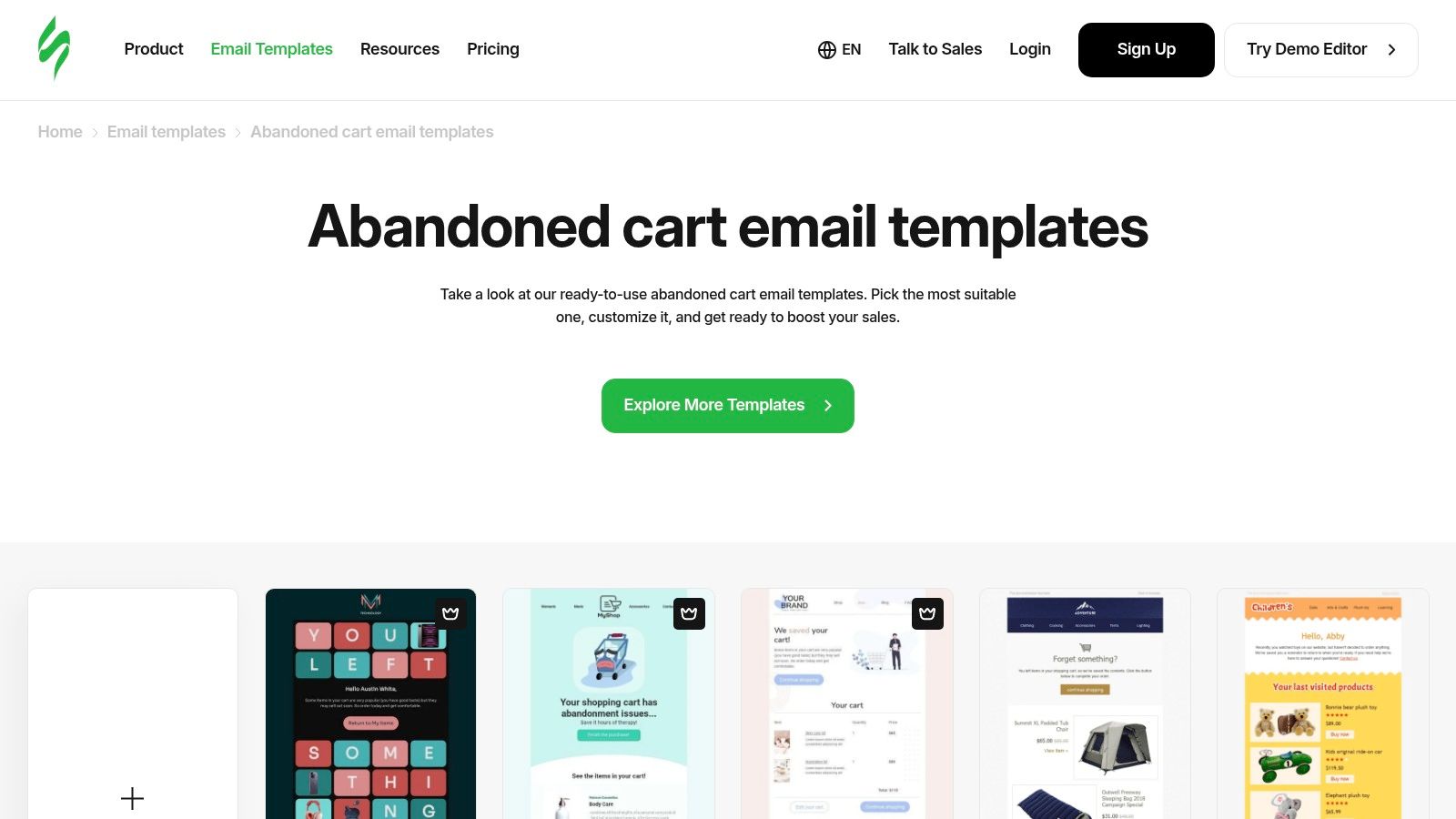
Strategic Breakdown & Key Features
Stripo's core strength is separating email design from email sending, giving marketers freedom from restrictive native editors.
- ESP-Agnostic Design: Build one master abandoned cart template and export it with one click to over 70 different ESPs. This saves countless hours for agencies or businesses running multiple stores.
- Modular Content Blocks: Create, save, and reuse custom content modules (like headers and footers) to ensure brand consistency across all your cart recovery emails.
- Smart Elements for Dynamic Content: Stripo offers guidance on configuring "smart" blocks that will be populated by your ESP’s data, bridging the gap between static design and dynamic content.
- Extensive Template Library: Access hundreds of templates designed for abandoned carts, which is a huge time-saver when you need to get a campaign live quickly.
Pricing and Access
Stripo offers a generous Free plan that includes 4 exports per month. Paid plans unlock more exports and advanced features. The main consideration is that Stripo creates the template; the automation triggers must be configured in your ESP. For getting a beautiful, responsive email built fast, explore their library at stripo.email.
7. Etsy: The Creative Marketplace for "Done-For-You" Templates
For brands looking for a quick launch without starting from scratch, Etsy has emerged as a surprising and valuable resource. It’s a marketplace not just for handmade goods, but for digital assets, including full-funnel abandoned cart email templates designed by e-commerce freelancers and agencies.
From our experience, many new store owners get paralyzed by the design and copywriting phase. Etsy removes this barrier by offering pre-built template packs. Most sellers provide a complete kit: editable Canva graphics, pre-written email copy for a multi-step sequence, and guides on how to import them into platforms like Klaviyo. It’s the fastest route from zero to a live, beautiful cart recovery flow.
Strategic Breakdown & Key Features
Think of Etsy as a creative accelerator. You purchase a proven framework that you can customize to fit your brand, saving dozens of hours.
- Ready-Made Multi-Email Sequences: Most sellers offer complete 3-to-4 email flows, including the strategic timing and copy needed to nurture a customer back to their cart.
- Canva-Editable Graphics: This is a key feature. You don’t need to be a graphic designer to customize the templates. Easily add your logo, change colors, and match your brand’s aesthetic.
- One-Time Purchase Model: Unlike a subscription, you buy the template pack once and own it forever. This is highly cost-effective for brands on a tight budget.
- Comprehensive Instructions: Reputable sellers provide detailed PDFs or video tutorials explaining how to import the flow into Klaviyo and customize the content.
Pricing and Access
Pricing on Etsy is a one-time purchase per template pack, typically ranging from $15 to $100. Access is instant via digital download. The primary consideration is that many of these templates are built for easy import into Klaviyo. Always read recent reviews to ensure quality before purchasing. You can browse the collection on the Etsy website.
Abandoned Cart Email Templates Comparison
Your Next Step: Turn Abandoned Carts into Your Biggest Revenue Channel
You now have a complete arsenal of tools and strategies to transform your approach to cart recovery. We've explored everything from native solutions like Shopify to the advanced automation of Klaviyo. The common thread is clear: a generic, one-size-fits-all approach is no longer enough. From our experience with over 500 Shopify stores, the difference between a 5% and a 25% recovery rate lies in a thoughtful, multi-channel strategy.
The abandoned cart email templates we've broken down are your foundation. But as we've seen, the real revenue uplift comes from moving beyond a single channel. The strategy that consistently delivers the best results for our clients is combining a solid email sequence with the immediacy and personal touch of WhatsApp.
Your Key Takeaways and Action Plan
To turn insight into action, focus on these three core principles:
- Go Beyond the Inbox: Don't rely solely on email. A common mistake we see is ignoring channels with near-perfect engagement. By integrating a WhatsApp flow, you tap into a 98% open rate, ensuring your message is seen. This multi-channel approach isn't just a nice-to-have; it's a critical competitive advantage.
- Hyper-Personalize Your Outreach: Use dynamic content to show customers a picture of the exact item they left behind. A generic "You left something in your cart" email is easily ignored; an email showing the exact pair of sneakers they wanted is a powerful reminder.
- Embrace Continuous Optimization: Your recovery sequence is not a "set it and forget it" machine. You must actively test. A/B test your subject lines, experiment with different offers (e.g., 10% off vs. free shipping), and adjust your timing. Track your metrics relentlessly to understand what motivates your customers.
The most effective abandoned cart email templates are simply the starting point. The goal is to build an automated, revenue-generating system that works for you 24/7, turning hesitant shoppers into loyal customers.
Ready to build a high-converting recovery flow on the channel with 98% open rates?
While powerful email templates are crucial, complementing them with WhatsApp automation is how top brands win. With Kanal, you can launch these conversational flows in minutes, recover lost sales automatically, and build stronger customer relationships. Install Kanal on your Shopify store today or schedule a demo to see how much revenue you're leaving on the table.

